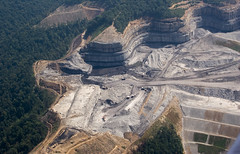“Areas with especially heavy mining have the highest unemployment rates in the region; contrary to the common perception that mining contributes to overall employment.” – Dr. Michael Hendryx
 Congressional Republicans, led by rogue Democratic Congressman Nick Rahall, will hold a hearing today in the Transportation and Infrastructure Committee’s Subcommittee on Water Resources and the Environment (phew!) that has absolutely nothing to do with reality. This farcical hearing, scheduled especially for Cinco De Mayo is EPICALLY titled: “ EPA Mining Policies: Assault on Appalachian Jobs – PART 1.” WAIT A SECOND?! What is this title, a Styx song? Is this seriously supposed to be a substantive Congressional hearing? There are plenty of jobs being lost, and population being lost, and lives being lost in Appalachia.
Congressional Republicans, led by rogue Democratic Congressman Nick Rahall, will hold a hearing today in the Transportation and Infrastructure Committee’s Subcommittee on Water Resources and the Environment (phew!) that has absolutely nothing to do with reality. This farcical hearing, scheduled especially for Cinco De Mayo is EPICALLY titled: “ EPA Mining Policies: Assault on Appalachian Jobs – PART 1.” WAIT A SECOND?! What is this title, a Styx song? Is this seriously supposed to be a substantive Congressional hearing? There are plenty of jobs being lost, and population being lost, and lives being lost in Appalachia.
But Rahall and co are missing a simple fact. Mining jobs are on the rise in Appalachia, and EPA’s policies are helping to create MORE mining jobs in the region. More on that below.
This is a complete and utter joke of a one-sided hearing, and a waste of our tax dollars. Not only that, but Rahall and his buddies running the subcommittee made sure to block out the voices of Appalachian citizens, scientists, and other rational people. Oh, and by the way…they DEMAND to be taken seriously.
—-
1) Mining Jobs
Lets talk about them. According to the Energy Information Administration, there are about 34,000 mining jobs in all of Central Appalachia (southern West Virginia, eastern Kentucky, Virginia, and a few counties in Tennessee) as of 2010. This includes “…all employees engaged in production, preparation, processing, development, maintenance, repair shop, or yard work at mining operations, including office workers.” This employment number is on the rise over the last decade even though coal production has plummeted in the region. Why? Because companies are relying on underground mining for an increasingly large share of their coal. Underground mining employs more people than mountaintop removal (one of a multitude of benefits you get from not blowing up a mountain and dumping the toxic waste into headwater streams.) So, why are we always showing you the graph below detailing the historical loss of mining jobs, specifically in West Virginia?

Because there IS an assault on mining jobs in Appalachia. Namely – MOUNTAINTOP REMOVAL, a practice used specifically to take the miner out of the mine.
Lets look at 2007-2010 when the US job market declined by 5% overall. During this period, production from mountaintop removal mines declined by 25% and employment at Central Appalachian coal mines increased. Claims by coal companies and their cronies in Congress that more stringent permitting of mountaintop removal is causing an economic crisis in Central Appalachia are simply false. Since 2007, as production in Central Appalachia has shifted away from mountaintop removal and back toward underground mining techniques, the increase in employment at underground mines has more than offset declines at other types of mines.
 Many companies proceed by replacing miners with machines and explosives. Underground mines, however, create 52% more job-hours than mountaintop removal mines for every ton they produce and employ nearly two thirds of the miners in Central Appalachia while producing just over half of the coal. In addition, unemployment in counties where a high proportion of coal is mined by mountaintop removal is higher than in counties where coal is mined mostly underground. According to data from the Bureau of Labor Statistics from 2000 through 2010, the average annual unemployment rate was 8.6% in Central Appalachian counties where more than 75% of coal production was by mountaintop removal, compared to 6.7% in counties where mountaintop removal accounted for less than 25% of production. )
Many companies proceed by replacing miners with machines and explosives. Underground mines, however, create 52% more job-hours than mountaintop removal mines for every ton they produce and employ nearly two thirds of the miners in Central Appalachia while producing just over half of the coal. In addition, unemployment in counties where a high proportion of coal is mined by mountaintop removal is higher than in counties where coal is mined mostly underground. According to data from the Bureau of Labor Statistics from 2000 through 2010, the average annual unemployment rate was 8.6% in Central Appalachian counties where more than 75% of coal production was by mountaintop removal, compared to 6.7% in counties where mountaintop removal accounted for less than 25% of production. )
SO, EPA’s continued protection of human health and clean water is driving production away from surface mining and towards underground mining, which employs far more people. Ergo (and this is the really important part)…
2) EPA’s mining policies are creating mining jobs in Central Appalachia that otherwise would not have existed. Meanwhile, the coal industry is making money hand over fist
WHAT?! How is that possible? I thought that the President had declared a war on coal, and was determined to shut down coal mining and to end coal and to kill coal and to destroy coal and to attack our way of life? I thought the EPA was a socialist plot to overthrow American businesses and values and freedoms and coal jobs and liberty?
YES, we’ve been subject to the networks and local politicians echoing what Mike Casey calls coal’s fantasy that this dirty fuel is a clean, sustainable, job creator. The truth is that reliance on coal mining has sucked the jobs, opportunity, and economic vitality out of huge swaths of Central Appalachia.
Casey says:
…[f]ossil fuel production has not insulated energy-producing states from fiscal crisis…[t]he volatility of fossil fuel markets poses obstacles to the stability and long-term security of economic growth in energy-producing regions.” …This is a problem for the coal industry, which spends heavily to construct a fantasy world in which it’s a “clean” industry to which we should feel grateful, a vital supplier of our power, and an economic lifeline to host communities.
Appalachia is hurting economically, in large part due to an overreliance on unsustainable mining practices. But its not like the coal industry itself is hurting under EPA’s current mining regulations. For Q1, coal companies are already bringing in the dough, with Alpha (who is buying out Massey Energy) just announcing that their Q1 profits had tripled! Patriot announced record revenue, with the boss saying;
…year-to-date coal production in Central Appalachia has increased over the prior year.
Arch is pulling a handsome profit, while specifically not citing EPA as a problem in driving up costs. CONSOL says they made record revenue, while the CEO stated:
“CONSOL Energy had a superb quarter, by nearly any measure,” commented J. Brett Harvey, chairman and chief executive officer…We also exceeded our expectations on coal production.”
How TERRIFICALLY annoying for all of us that Congressman Rahall doesn’t have the slightest clue what he is doing when it comes to making public policy..
3. What exactly is EPA regulating? Mainly, valleyfills. A majority of new mines in Central Appalachia don’t use valleyfills.
The majority of recently approved permits for new mines in Central Appalachia do not even use valley fills. A survey of all applications for new mine permits in Central Appalachia that were approved by state agencies in 2009 revealed that just 44% used valley fills to dispose of mine waste. Valleyfills, whose impacts are known to be deadly, dangerous, and permanent, are a very small and unnecessary part of Appalachian surface mining.
 Central Appalachian production is declining, with mountaintop removal making up less than 5% of US electricity generation. The bottom line is that U.S. coal production is limited by demand for coal, not by the ability of companies to obtain permits for mountaintop removal mines. According to energy analysts as well as executives from Arch Coal, Peabody Energy, and Southern Company, declining Central Appalachian coal production is the result of competition from lower cost natural gas. Coal mines across the country are producing at just 75% of their capacity – down from 85% in 2008 – and the Energy Information Administration projects that coal demand won’t recover to 2008 levels for another 15 years. Coal from mountaintop removal mines could easily be replaced if other US mines were operating at just 81% of their capacity. So, theres that.
Central Appalachian production is declining, with mountaintop removal making up less than 5% of US electricity generation. The bottom line is that U.S. coal production is limited by demand for coal, not by the ability of companies to obtain permits for mountaintop removal mines. According to energy analysts as well as executives from Arch Coal, Peabody Energy, and Southern Company, declining Central Appalachian coal production is the result of competition from lower cost natural gas. Coal mines across the country are producing at just 75% of their capacity – down from 85% in 2008 – and the Energy Information Administration projects that coal demand won’t recover to 2008 levels for another 15 years. Coal from mountaintop removal mines could easily be replaced if other US mines were operating at just 81% of their capacity. So, theres that.
If Congressman Rahall knew the first thing about Central Appalachian mining, he might include some expert witnesses, or citizens whose lives are forever impacted by the very unnecessary (and unpopular) method of mining called mountaintop removal. Poll after poll show that a majority of people across America and across Appalachia oppose mountaintop removal. His constituents seem to agree, as Rahall’s district in southern West Virginia is being swiftly depopulated.
But hey, at least the citizens of WV-03 still have it better off than their neighbors in KY-05, the only district with MORE mountaintop removal.

We all have ideas on how to provide job growth and economic opportunity for our region, but one thing is clear. MORE mountaintop removal is not the answer. There are real problems to be addressed in Appalachia and this goofy hearing is a great big whiff.




 To many of who have been raised, like myself, in the Appalachian Mountains, they are hallowed ground. The Appalachian Mountains was a haven during the last Ice Age and helped reseed the planet after. For early Native Americans, they honored the land for they felt it gave them life, seeing the Appalachian Mountains as fertile and used it as hunting grounds. They never raped the land and gave back to it when they could. To the early Europeans settling the new land they called America, it was a new beginning filled with the mystery of the mountains in the horizon. And as a new nation was born, the United States of America, the Appalachian Mountains became its first frontier filled with adventure and struggle. The mountains developed a history as vivid as that of the “Old West.” A history of life and death, of struggle and prosperity. These mountains became home to its earliest pioneers, and like the Native Americans before them, many were laid to rest in them. I am proud to be descendant of some of Appalachia’s earliest settlers. Like the Native Americans before me, I feel the land of these beautiful mountains gave me life. They hold my heritage and sense of home, and their essence is my very core of existence.
To many of who have been raised, like myself, in the Appalachian Mountains, they are hallowed ground. The Appalachian Mountains was a haven during the last Ice Age and helped reseed the planet after. For early Native Americans, they honored the land for they felt it gave them life, seeing the Appalachian Mountains as fertile and used it as hunting grounds. They never raped the land and gave back to it when they could. To the early Europeans settling the new land they called America, it was a new beginning filled with the mystery of the mountains in the horizon. And as a new nation was born, the United States of America, the Appalachian Mountains became its first frontier filled with adventure and struggle. The mountains developed a history as vivid as that of the “Old West.” A history of life and death, of struggle and prosperity. These mountains became home to its earliest pioneers, and like the Native Americans before them, many were laid to rest in them. I am proud to be descendant of some of Appalachia’s earliest settlers. Like the Native Americans before me, I feel the land of these beautiful mountains gave me life. They hold my heritage and sense of home, and their essence is my very core of existence.
 2/3 Goat are trying to get the goat of the coal industry, and we support them whole-heartedly.
2/3 Goat are trying to get the goat of the coal industry, and we support them whole-heartedly.
 This month Congress held two pro-mountaintop removal hearings on EPA policies where the Committee attempted to shut out citizens, scientists from the region, and experts on the issue of mountaintop removal. We are very honored to have this post from Mr. Patrick Morales, an Appalachian citizen who came all the way to Washington DC to tell Nick Rahall, Bob Gibbs, and the rest of their ridiculous crew that he and his family would not be ignored, despite the Committee’s attempts to block Appalachian citizens voice while removing important citizen protections from mountaintop removal. Do you agree that Appalachian citizens deserve a voice in Washington DC?
This month Congress held two pro-mountaintop removal hearings on EPA policies where the Committee attempted to shut out citizens, scientists from the region, and experts on the issue of mountaintop removal. We are very honored to have this post from Mr. Patrick Morales, an Appalachian citizen who came all the way to Washington DC to tell Nick Rahall, Bob Gibbs, and the rest of their ridiculous crew that he and his family would not be ignored, despite the Committee’s attempts to block Appalachian citizens voice while removing important citizen protections from mountaintop removal. Do you agree that Appalachian citizens deserve a voice in Washington DC? 


 Congressional Republicans, led by rogue Democratic Congressman Nick Rahall, will hold a hearing today in the Transportation and Infrastructure Committee’s Subcommittee on Water Resources and the Environment (phew!) that has absolutely nothing to do with reality. This farcical hearing, scheduled especially for Cinco De Mayo is EPICALLY titled: “
Congressional Republicans, led by rogue Democratic Congressman Nick Rahall, will hold a hearing today in the Transportation and Infrastructure Committee’s Subcommittee on Water Resources and the Environment (phew!) that has absolutely nothing to do with reality. This farcical hearing, scheduled especially for Cinco De Mayo is EPICALLY titled: “

 Central Appalachian production is declining, with mountaintop removal making up less than 5% of US electricity generation. The bottom line is that U.S. coal production is limited by demand for coal, not by the ability of companies to obtain permits for mountaintop removal mines. According to energy analysts as well as executives from Arch Coal, Peabody Energy, and Southern Company, declining Central Appalachian coal production is the result of competition from lower cost natural gas. Coal mines across the country are producing at just 75% of their capacity – down from 85% in 2008 – and the Energy Information Administration projects that coal demand won’t recover to 2008 levels for another 15 years. Coal from mountaintop removal mines could easily be replaced if other US mines were operating at just 81% of their capacity. So, theres that.
Central Appalachian production is declining, with mountaintop removal making up less than 5% of US electricity generation. The bottom line is that U.S. coal production is limited by demand for coal, not by the ability of companies to obtain permits for mountaintop removal mines. According to energy analysts as well as executives from Arch Coal, Peabody Energy, and Southern Company, declining Central Appalachian coal production is the result of competition from lower cost natural gas. Coal mines across the country are producing at just 75% of their capacity – down from 85% in 2008 – and the Energy Information Administration projects that coal demand won’t recover to 2008 levels for another 15 years. Coal from mountaintop removal mines could easily be replaced if other US mines were operating at just 81% of their capacity. So, theres that.
